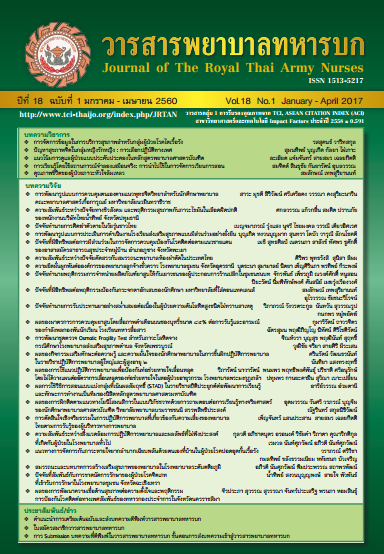ผลของการใช้แนวปฏิบัติการพยาบาลเพื่อป้องกันท่อช่วยหายใจเลื่อนหลุด โดยไม่ได้วางแผนต่ออัตราการเลื่อนหลุดของท่อช่วยหายใจ ในหอผู้ป่วยอายุรกรรม โรงพยาบาลพระมงกุฎเกล้า
Keywords:
แนวปฏิบัติการพยาบาล, การเลื่อนหลุดของท่อช่วยหายใจโดยไม่ได้วางแผน, Clinical Practice Nursing Guideline, Unplanned ExtubationAbstract
การวิจัยครั้งนี้เป็นการศึกษาเชิงพรรณา เพื่อศึกษาอัตราการเกิดท่อช่วยหายใจเลื่อนหลุดโดยไม่ได้วางแผนภายหลังการใช้ PMK Unplanned Extubation Prevention Program โดยแนวปฏิบัตินี้ประกอบด้วย 2 หมวด ได้แก่ 1) การประเมินความเสี่ยงการเลื่อนหลุดของท่อช่วยหายใจ และ 2) การพยาบาลเพื่อป้องกัน UE ประกอบด้วย 1) การให้ข้อมูล 2) การสื่อสาร 3) การยึดตรึงท่อช่วยหายใจและ 4) การผูกยึดร่างกาย คณะผู้วิจัยจัดทำโครงการฝึกอบรมเชิงปฏิบัติการแก่พยาบาลวิชาชีพ และนำแนวปฏิบัติไปใช้กับกลุ่มตัวอย่างจำนวน 205 คน ตั้งแต่ 1 มีนาคม ถึง 30 กันยายน 2558 จากการศึกษาพบว่า การประเมินความเสี่ยงการเลื่อนหลุดของท่อช่วยหายใจปฏิบัติได้ร้อยละ 98.5 การให้ข้อมูลปฏิบัติได้ร้อยละ 96.3 การสื่อสารปฏิบัติได้ร้อยละ 88.7 การยึดตรึงท่อช่วยหายใจปฏิบัติได้ร้อยละ 89.2 และการผูกยึดปฎิบัติได้ร้อยละ 66.6 เกิด UE จำนวน 8 ราย คิดเป็น 1.43 ครั้งต่อ 1,000 วันใส่เครื่องช่วยหายใจ ดังนั้นการนำ PMK Unplanned Extubation Prevention Program มาใช้ในการดูแล บุคลากรทางพยาบาลต้องมีความตระหนักและเคร่งครัดในการป้องกัน จึงจะทำให้การดูแลผู้ป่วยใส่ท่อช่วยหายใจได้มาตรฐานและเกิดผลลัพธ์ที่ดี
Effect of PMK Unplanned Extubation Prevention Program on Extubation Rate in Medical Wards, Phramongkutklao Hospital
This research is a descriptive study which aimed to study the Unplanned extubation (UE) rate after the program implementation. The set goal of UE rate was not more than 3 times per 1,000 intubation days. This program consisted of 1) risk assessment for UE 2) Nursing practice guideline for UE prevention which included giving information for patients and their family, effective communication, effective intubating tube fixation and appropriate restraint. The research instruments were 1) recording form for patients’ general and illness information 2) nursing practice recording form for UE prevention and 3) recording form of UE incidents. The instruments were validated by 3 experts and the reliability tested by inter-rater reliability approach was 0.87. At the beginning of the program, a workshop focusing on clinical nursing guideline for UE prevention was initiated for 205 nurses in Medical ICUs and medical wards. Then the program was implemented between 1st /March/- 30th /September, 2015. The results show that 98.5% of intubated patients were assessed for UE risks correctly and 96.3% of the patients and family were given information. Further, Effective communication and effective intubating tube fixation were practiced by nurses at 88.7 and 89.2 respectively. Whereas, appropriate restraint could be performed only 66.6%. There were 8 cases in total reported for UE during the study period, accounting for 1.43 times per 1000 intubation days. In conclusion, the UE prevention program was effective in reducing UE rate among intubated patients. Positive attitude toward the incident prevention, strict nursing practice as the guideline and effective communication between healthcare team, patients and their family are the keys to maximize the patient outcome.
Downloads
Downloads
How to Cite
Issue
Section
License
บทความหรือข้อคิดเห็นใดใดที่ปรากฏในวารสารพยาบาลทหารบกเป็นวรรณกรรมของผู้เขียน ซึ่งบรรณาธิการหรือสมาคมพยาบาลทหารบก ไม่จำเป็นต้องเห็นด้วย
บทความที่ได้รับการตีพิมพ์เป็นลิขสิทธิ์ของวารสารพยาบาลทหารบก
The ideas and opinions expressed in the Journal of The Royal Thai Army Nurses are those of the authors and not necessarily those
of the editor or Royal Thai Army Nurses Association.






